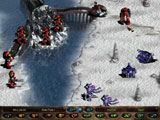 Over the last few years, SSI has released two of my favorite
games—Panzer General II, a stylish upgrade to the classic Panzer General, and Chaos
Gate, an overlooked gem of a game that takes place in Games Workshop’s Warhammer 40K
universe. So I was more than a little excited when I heard that SSI was going to produce
Warhammer 40K:Rites of War, a game that combines the PGII engine with the 40K universe.
And Rites of War gets a lot of things right. The game’s graphics are terrific, the
interface is improved, and the game does a good job of evoking the dark 40K world.
Unfortunately, the gameplay isn’t as cool as everything else. The campaign is very
linear, the AI is a little dense, and each of the 24 scenarios plays out much like the one
before it.
Over the last few years, SSI has released two of my favorite
games—Panzer General II, a stylish upgrade to the classic Panzer General, and Chaos
Gate, an overlooked gem of a game that takes place in Games Workshop’s Warhammer 40K
universe. So I was more than a little excited when I heard that SSI was going to produce
Warhammer 40K:Rites of War, a game that combines the PGII engine with the 40K universe.
And Rites of War gets a lot of things right. The game’s graphics are terrific, the
interface is improved, and the game does a good job of evoking the dark 40K world.
Unfortunately, the gameplay isn’t as cool as everything else. The campaign is very
linear, the AI is a little dense, and each of the 24 scenarios plays out much like the one
before it. 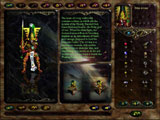 In
Rites of War, you take command of the Eldar army. The Eldar have always been one of the
most popular races amongst 40K gamers, but until now they’ve been unrepresented in PC
games. Eldar are essentially Space Elves, and like their fantasy cousins they’re an
enigmatic, graceful, sometimes brooding race. They’re also on the verge of
extinction. In Rites of War, you take command of an Eldar army tasked to prevent human
settlers from discovering ancient artifacts on a previously deserted world, Davinuus. When
your troops come under unprovoked attack, it becomes evident something’s rotten in
Davinuus, and for the next 24 scenarios your army goes about setting things right. In the
course of your battles, you’ll discover terrible secrets (including a Tyranid
infestation) and valuable artifacts, and eventually engage in a life-or-death struggle for
the planet with the Tyranid hive mind.
In
Rites of War, you take command of the Eldar army. The Eldar have always been one of the
most popular races amongst 40K gamers, but until now they’ve been unrepresented in PC
games. Eldar are essentially Space Elves, and like their fantasy cousins they’re an
enigmatic, graceful, sometimes brooding race. They’re also on the verge of
extinction. In Rites of War, you take command of an Eldar army tasked to prevent human
settlers from discovering ancient artifacts on a previously deserted world, Davinuus. When
your troops come under unprovoked attack, it becomes evident something’s rotten in
Davinuus, and for the next 24 scenarios your army goes about setting things right. In the
course of your battles, you’ll discover terrible secrets (including a Tyranid
infestation) and valuable artifacts, and eventually engage in a life-or-death struggle for
the planet with the Tyranid hive mind.
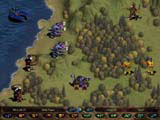 For you
veteran 40K players, the game’s graphics and feel owe more to the late, lamented
second edition rules than to the new third edition—which makes sense, since the game
has been in production for a few years, and the new Eldar codex isn’t even due out
until next week. The units look like second edition figures, there are still strategy
cards, psykers are pretty powerful, and many of the annoying things about the old Eldar
are still here—like overpowered exarch units with cheese wargear. But don’t
think this game plays like the tabletop game—it plays like the turn-based Panzer
General II with a coat of 40K paint.
For you
veteran 40K players, the game’s graphics and feel owe more to the late, lamented
second edition rules than to the new third edition—which makes sense, since the game
has been in production for a few years, and the new Eldar codex isn’t even due out
until next week. The units look like second edition figures, there are still strategy
cards, psykers are pretty powerful, and many of the annoying things about the old Eldar
are still here—like overpowered exarch units with cheese wargear. But don’t
think this game plays like the tabletop game—it plays like the turn-based Panzer
General II with a coat of 40K paint.
But what a coat of paint. A large part of 40K’s draw is its beautifully painted
figures and detailed game boards, and Rites of War captures the Games Workshop look
perfectly. The animated unit sprites are much larger than the ones found in Panzer General
II, and combat and spell graphic effects are right on the money, from the slashing
chainsword of the Striking Scorpions to the whirling vortex effect of the deadly D-cannon.
The terrain is striking as well. It’s a bit more subdued than the colorful units, but
if you liked the PGII’s hand-painted maps, you’ll love these.
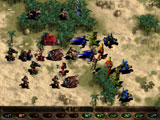 As you
progress in the campaign, more and more units will become available to you, and a good
part of the fun in Rites of War comes from managing your army. As you win victories, you
gain "glory points" which can be used to purchase new units. As units gain
experience, they’ll become much more effective. You’ll also get the opportunity
to upgrade your units. Thus the plebian Eldar Guadians can, given enough experience, be
upgraded to the much more powerful aspect warriors, who can then be upgraded into kick-ass
exarchs. You’ll also discover powerful Eldar artifacts during your battles, which
grant special bonuses to your units. Since exarchs can also purchase special exarch
skills, it doesn’t take long before you have some extremely powerful units on the
board.
As you
progress in the campaign, more and more units will become available to you, and a good
part of the fun in Rites of War comes from managing your army. As you win victories, you
gain "glory points" which can be used to purchase new units. As units gain
experience, they’ll become much more effective. You’ll also get the opportunity
to upgrade your units. Thus the plebian Eldar Guadians can, given enough experience, be
upgraded to the much more powerful aspect warriors, who can then be upgraded into kick-ass
exarchs. You’ll also discover powerful Eldar artifacts during your battles, which
grant special bonuses to your units. Since exarchs can also purchase special exarch
skills, it doesn’t take long before you have some extremely powerful units on the
board.
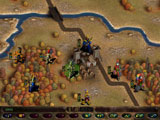 Which is
perhaps the biggest problem with Rites of War. The campaign game just isn’t very well
balanced, especially the last half of the game. Early on, things can be quite tense, as
the human Imperial troops—made up of Imperial Guard and Space Marines—give you a
tough run for your money. But as your units improve, the scenarios become much less
daunting. Partly this is due to the very buff wargear-laden units under your command, but
it may have something to do with your new opponents—the Alien-like Tyranids.
‘Nids were always one of the weak sister armies in second edition 40K. They depended
on closing and getting into hand-to-hand combat, and the second edition rules made that
very hard to do. It took a very skilled ‘Nid player to defeat the massed firepower of
Space Marines and Eldar. The game mechanics are of course very different in Rites of War
than they are in 40K, but the principle that will utterly shred Tyranid armies remains the
same—make them charge into sheets of gunfire. This is easily done by supporting your
tactical troops with close support units, then sitting back and watching the bugs throw
themselves piecemeal at your line. The enemy AI never seems to figure this out.
Which is
perhaps the biggest problem with Rites of War. The campaign game just isn’t very well
balanced, especially the last half of the game. Early on, things can be quite tense, as
the human Imperial troops—made up of Imperial Guard and Space Marines—give you a
tough run for your money. But as your units improve, the scenarios become much less
daunting. Partly this is due to the very buff wargear-laden units under your command, but
it may have something to do with your new opponents—the Alien-like Tyranids.
‘Nids were always one of the weak sister armies in second edition 40K. They depended
on closing and getting into hand-to-hand combat, and the second edition rules made that
very hard to do. It took a very skilled ‘Nid player to defeat the massed firepower of
Space Marines and Eldar. The game mechanics are of course very different in Rites of War
than they are in 40K, but the principle that will utterly shred Tyranid armies remains the
same—make them charge into sheets of gunfire. This is easily done by supporting your
tactical troops with close support units, then sitting back and watching the bugs throw
themselves piecemeal at your line. The enemy AI never seems to figure this out.
Making matters worse is the very generous 40-turn limit that most of the scenarios
impose. Since there’s no rush to get things done, and most of the scenario objectives
consist of making your way across the map to take victory hexes, you can stroll across the
map in supported line formation like a Napoleonic regiment, slaughtering even the most
powerful of the fragmented ‘Nid forces. This surprisingly effective tactic isn’t
much fun, but it’s almost forced upon you.
Since the campaign isn’t very challenging, mulitplayer may be the way to
go—the game contains most of the usual options, though it lacks a PBEM option, which
seems odd in a turn-based SSI game.
Given my high expectations, Rites of War is a bit of a disappointment. Though very
good-looking, stable, and true to the 40K vision, the gameplay just isn’t there. It
kept me just interested enough to play through the campaign—and I had a pretty good
time doing it--but I won’t be playing it again.
--Rick Fehrenbacher

 Over the last few years, SSI has released two of my favorite
games—Panzer General II, a stylish upgrade to the classic Panzer General, and Chaos
Gate, an overlooked gem of a game that takes place in Games Workshop’s Warhammer 40K
universe. So I was more than a little excited when I heard that SSI was going to produce
Warhammer 40K:Rites of War, a game that combines the PGII engine with the 40K universe.
And Rites of War gets a lot of things right. The game’s graphics are terrific, the
interface is improved, and the game does a good job of evoking the dark 40K world.
Unfortunately, the gameplay isn’t as cool as everything else. The campaign is very
linear, the AI is a little dense, and each of the 24 scenarios plays out much like the one
before it.
Over the last few years, SSI has released two of my favorite
games—Panzer General II, a stylish upgrade to the classic Panzer General, and Chaos
Gate, an overlooked gem of a game that takes place in Games Workshop’s Warhammer 40K
universe. So I was more than a little excited when I heard that SSI was going to produce
Warhammer 40K:Rites of War, a game that combines the PGII engine with the 40K universe.
And Rites of War gets a lot of things right. The game’s graphics are terrific, the
interface is improved, and the game does a good job of evoking the dark 40K world.
Unfortunately, the gameplay isn’t as cool as everything else. The campaign is very
linear, the AI is a little dense, and each of the 24 scenarios plays out much like the one
before it.